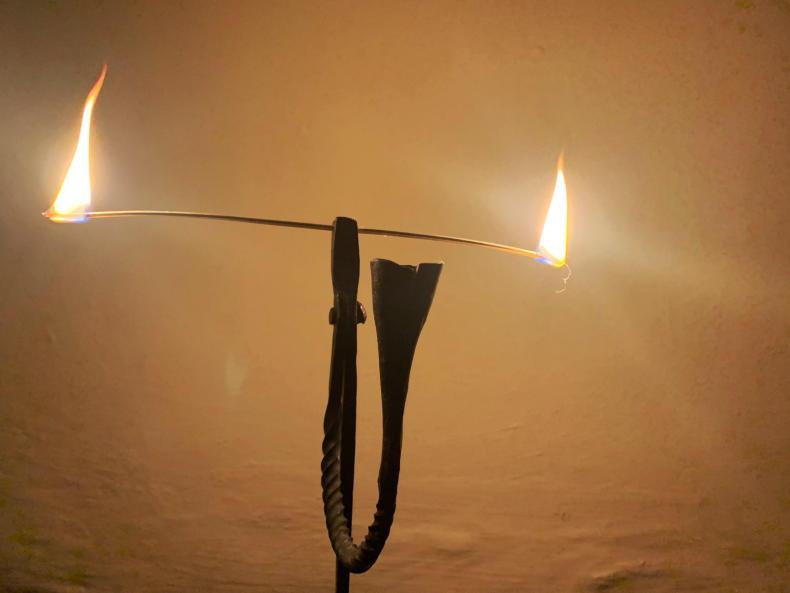The clocks have gone back, but there is no way of getting away from the dark as the Irish winter settles in. The long summer evenings with glowing red sunsets are well behind us and as we move towards the solstice and Christmas, we are engulfed in darkness. We rely now on the electric light to manage the night while a generation or two before us looked to the paraffin oil, double-burning wick lamps or the pressurised Tilley lamps with their glowing globes. These oil lamps were high technology in their day but for most rural Irish people in the 19th century, the chief source of light was the simple candle.
Rathbornes in Dublin, established in Winetavern Street in 1488, were amongst the first professional chandlers to produced candles commercially. Through time, the specialist chandlers have utilised a variety of different waxes and fats: everything from paraffin wax to beeswax to spermaceti (a waxy oil found in the head cavity of the sperm whale) and of course, all manner of rendered animal fat. In the countryside, generally, these superior candles would only have been bought and used on special occasions such as wakes, the station mass or at Christmas time. The candle for everyday use was a pure, vernacular, homemade thing: the rushlight.
Making a rushlight
In wet, marshy land and along the banks of rivers and small streams, growing in distinctive clumps or tufts, one finds the common rush (Juncus conglomeratus). The foam-like centre of this rush was used as the wick for the simplest form of candle. The rushes were best cut when they were green and ripe, in late summer and early autumn or at least before the winter frosts turn them brown and useless. Once cut, the rushes were kept in a bucket of water to stop them from drying out, ready for the slow and deliberate process of peeling off the hard green outside layer to expose the soft pith.
The trick was to peel off most of the rind but to leave a long narrow strip of green skin running down the length of the rush that afforded it stability and strength. A task that is easier said than done. The peeled rushes are about two feet long and tend to curl as they dry, so tying them loosely to a length of stick keeps them straight. In the past, they were left for a few days and nights to “ripen”, absorbing the dew of the morning while bleaching in the sun by day, resulting in a clean, white, dry wick. The peeled rushes were taken and left in an open airy spot close by the fire to dry out completely.
The dry rushes were ready to be loaded with grease and the main ingredient for such was tallow, rendered from the fat of any slaughtered animal or fowl. The suet fat surrounding the kidneys and loins in beef, mutton and kid was considered best. Pig lard from home pig-killing spluttered, smoked and smelt and it was often easier to buy a shop-bought dipped tallow “penny candle” and melt it down, providing enough grease to make anything up to 30 rushlights.
The inconspicuous rushlight might be considered unsophisticated and primitive, yet it is one of the greatest of all human accomplishments.
The soft, dry sponge of the exposed rush pith soaked up the melted fat instantly. The fat-laden rushes were now laid on a piece of timber or bark to dry and in some parts of the country, a piece of badger skin, hanging in the rafters, was considered the best for curing and storage. It was important to keep the tallow rush-lights out of reach of the cat or indeed, mice and rats, who looked on these lengths of fat as irresistible snacks!
Burning at both ends
When employed to provide light, the rush tapers were fixed in a special rushlight holder, made by the local blacksmith. These holders took the form of two pieces of iron riveted together to form a set of nips or pincers, which stood upright in a solid block of wood. The rush-light was set at an angle of 45 degrees and needed to be adjusted occasionally through the claws as it burned down. The flame provided a surprisingly effective light against the dark and one rushlight would provide enough light for around one hour. If more light was needed it was possible to set the rushlight horizontally - and note this is the only candle that allows this - one can, as the proverb tells us, “light the candle at both ends!”
The inconspicuous rushlight might be considered unsophisticated and primitive, yet it is one of the greatest of all human accomplishments. To light up the dark, to be able to see and function, is a quantum step in our evolution and the vernacular rushlight is a primal exponent of the story of human endeavour.
Shane Lehane is a folklorist who works in UCC and Cork College of FET, Tramore Road Campus. Contact: shane.lehane@csn.ie
Read more
Folklore with Shane Lehane: knotted in love
Folklore with Shane Lehane: the bog in May
The clocks have gone back, but there is no way of getting away from the dark as the Irish winter settles in. The long summer evenings with glowing red sunsets are well behind us and as we move towards the solstice and Christmas, we are engulfed in darkness. We rely now on the electric light to manage the night while a generation or two before us looked to the paraffin oil, double-burning wick lamps or the pressurised Tilley lamps with their glowing globes. These oil lamps were high technology in their day but for most rural Irish people in the 19th century, the chief source of light was the simple candle.
Rathbornes in Dublin, established in Winetavern Street in 1488, were amongst the first professional chandlers to produced candles commercially. Through time, the specialist chandlers have utilised a variety of different waxes and fats: everything from paraffin wax to beeswax to spermaceti (a waxy oil found in the head cavity of the sperm whale) and of course, all manner of rendered animal fat. In the countryside, generally, these superior candles would only have been bought and used on special occasions such as wakes, the station mass or at Christmas time. The candle for everyday use was a pure, vernacular, homemade thing: the rushlight.
Making a rushlight
In wet, marshy land and along the banks of rivers and small streams, growing in distinctive clumps or tufts, one finds the common rush (Juncus conglomeratus). The foam-like centre of this rush was used as the wick for the simplest form of candle. The rushes were best cut when they were green and ripe, in late summer and early autumn or at least before the winter frosts turn them brown and useless. Once cut, the rushes were kept in a bucket of water to stop them from drying out, ready for the slow and deliberate process of peeling off the hard green outside layer to expose the soft pith.
The trick was to peel off most of the rind but to leave a long narrow strip of green skin running down the length of the rush that afforded it stability and strength. A task that is easier said than done. The peeled rushes are about two feet long and tend to curl as they dry, so tying them loosely to a length of stick keeps them straight. In the past, they were left for a few days and nights to “ripen”, absorbing the dew of the morning while bleaching in the sun by day, resulting in a clean, white, dry wick. The peeled rushes were taken and left in an open airy spot close by the fire to dry out completely.
The dry rushes were ready to be loaded with grease and the main ingredient for such was tallow, rendered from the fat of any slaughtered animal or fowl. The suet fat surrounding the kidneys and loins in beef, mutton and kid was considered best. Pig lard from home pig-killing spluttered, smoked and smelt and it was often easier to buy a shop-bought dipped tallow “penny candle” and melt it down, providing enough grease to make anything up to 30 rushlights.
The inconspicuous rushlight might be considered unsophisticated and primitive, yet it is one of the greatest of all human accomplishments.
The soft, dry sponge of the exposed rush pith soaked up the melted fat instantly. The fat-laden rushes were now laid on a piece of timber or bark to dry and in some parts of the country, a piece of badger skin, hanging in the rafters, was considered the best for curing and storage. It was important to keep the tallow rush-lights out of reach of the cat or indeed, mice and rats, who looked on these lengths of fat as irresistible snacks!
Burning at both ends
When employed to provide light, the rush tapers were fixed in a special rushlight holder, made by the local blacksmith. These holders took the form of two pieces of iron riveted together to form a set of nips or pincers, which stood upright in a solid block of wood. The rush-light was set at an angle of 45 degrees and needed to be adjusted occasionally through the claws as it burned down. The flame provided a surprisingly effective light against the dark and one rushlight would provide enough light for around one hour. If more light was needed it was possible to set the rushlight horizontally - and note this is the only candle that allows this - one can, as the proverb tells us, “light the candle at both ends!”
The inconspicuous rushlight might be considered unsophisticated and primitive, yet it is one of the greatest of all human accomplishments. To light up the dark, to be able to see and function, is a quantum step in our evolution and the vernacular rushlight is a primal exponent of the story of human endeavour.
Shane Lehane is a folklorist who works in UCC and Cork College of FET, Tramore Road Campus. Contact: shane.lehane@csn.ie
Read more
Folklore with Shane Lehane: knotted in love
Folklore with Shane Lehane: the bog in May









SHARING OPTIONS